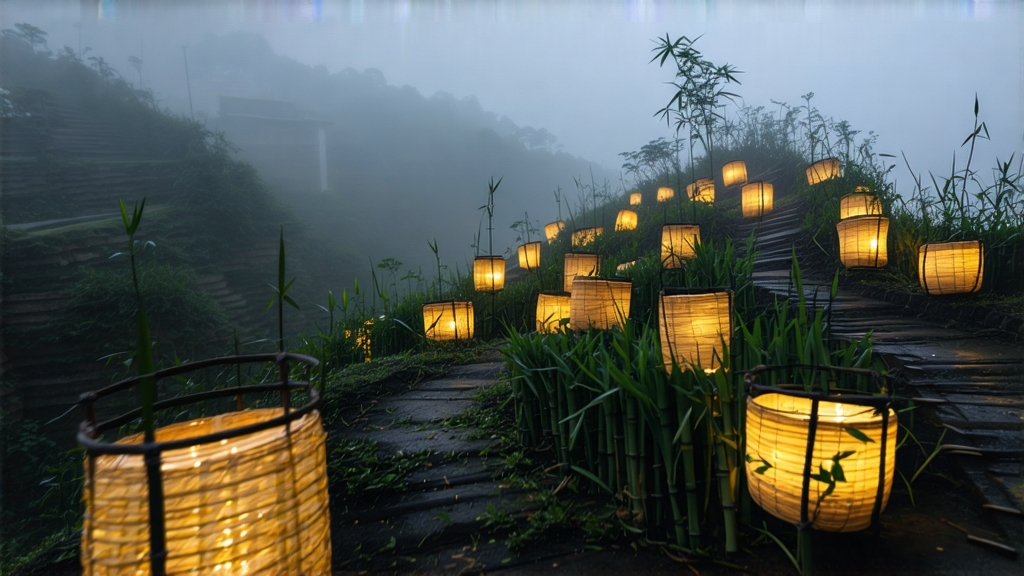
If green tea is the fresh-faced youth of Chinese tea and pu-erh the wise elder, then yellow tea is the discreet scholar who appears only when the moment is perfect. Among the handful of authentic yellow teas still crafted today, Meng Ding Huang Ya—literally “Yellow Bud from Meng Peak”—carries the rarest blend of imperial pedigree, alpine terroir and a micro-fermentation so subtle that even seasoned tasters sometimes mistake it for a green tea. Produced exclusively on the mist-capped ridges of Meng Ding Shan in Ya’an, Sichuan, this tea was already listed as tribute in A.D. 742 during the Tang dynasty, yet it remains almost unknown outside China. The following 2,000-word portrait invites the global tea traveler to discover why Meng Ding Huang Ya is considered the living fossil of Chinese tea art.
-
Geography: where clouds polish jade
Meng Ding Shan rises abruptly from the western rim of the Sichuan basin to 1,456 m, trapping moist monsoon clouds that shroud the gardens 280 days a year. Average humidity hovers at 85 %, while diurnal temperature swings can exceed 12 °C between dawn and noon. Such conditions slow photosynthesis, allowing amino acids—especially L-theanine—to accumulate in the tiny spring buds. The soil is acid yellow loam rich in selenium and zinc, leached from the same Tibetan Plateau limestone that feeds the nearby Min River. Because the mountain is too steep for large plantations, tea grows in scattered pockets hemmed by wild bamboo, ginkgo and flowering dogwood, creating a natural insectary that eliminates the need for pesticides. Every April, when night temperatures drop below 10 °C, the bushes enter a brief “cold dormancy” that tightens the cell structure of the buds, giving them a glassy jade color and the famous “needle” shape that will later turn primrose yellow during yellowing. -
A 1,200-year tribute chronicle
The first written record appears in the Tang national register of tributes (《唐本草》), where Ya’an county is ordered to forward “mengding stone-flower” to Chang’an. By the Song dynasty the name had crystallised into Huang Ya; Emperor Huizong, himself a tea connoisseur, reserved 500 jin (300 kg) for the palace and prohibited commoners from picking on pain of flogging. Ming scholars celebrated its “three yellows”: dry leaf, liquor and infused leaf all carrying a golden hue. When the Qing court switched its allegiance to compressed dark teas for the horse-trade routes, Meng Ding Huang Ya lost official patronage and retreated into monastic production. Only in 1959 did the Sichuan Tea Company revive the craft, selecting 13 hereditary families who still guarded the yellowing chambers. Today less than 3,000 kg of authentic Meng Ding Huang Ya reach the market each year, making it rarer per capita than first-growth Bordeaux. -
Harvest calendar: the 9-day window
Authentic Huang Ya is picked only between Qingming (early April) and Grain Rain (late April), when the bud reaches 18–22 mm but has not yet unfurled into a leaf. Each pluck must satisfy the “three consistencies”: length, color (jade-white sheen) and weight (0.12–0.15 g per bud). Experienced pickers work from 05:30 to 09:00, before mountain mist lifts and buds warm, because warmer temperatures activate polyphenol oxidase that would complicate later yellowing. A master can gather just 400 g of fresh buds per hour; 45,000 buds—an entire day’s labor for five pickers—yield only 500 g of finished tea. -
Craft: the lost 48 hours of “sealed yellowing”
Although yellow tea is often described as “green tea with an extra step,” that step is in fact a labyrinth of micro-decisions that can fail with one impatient hour. After picking, buds are spread 3 cm thick on bamboo trays and withered for 3–4 hours to reduce moisture to 68 %. The first fixation follows: wok temperatures are set to 160 °C for 90 seconds, high enough to kill grassiness yet low enough to leave 12–15 % enzymatic activity. While green tea would now be rolled and dried, Huang Ya enters the “men huang” (闷黄) phase, literally “sealed yellowing.”
The traditional method uses three layers: a bottom tray of smoked mulberry paper, a middle layer of buds